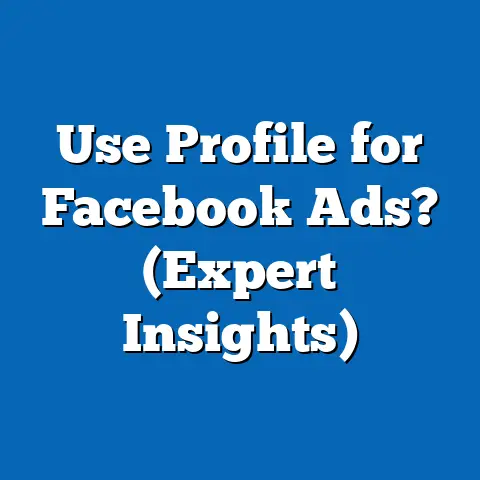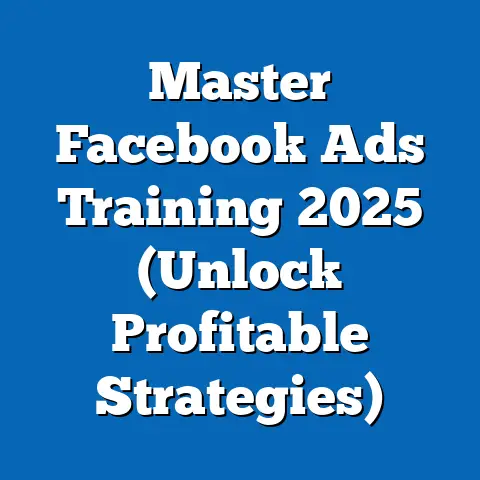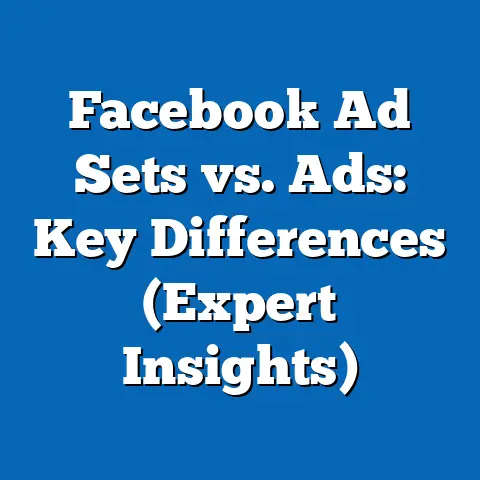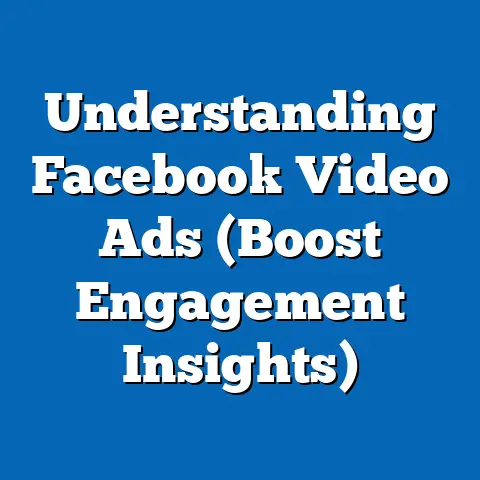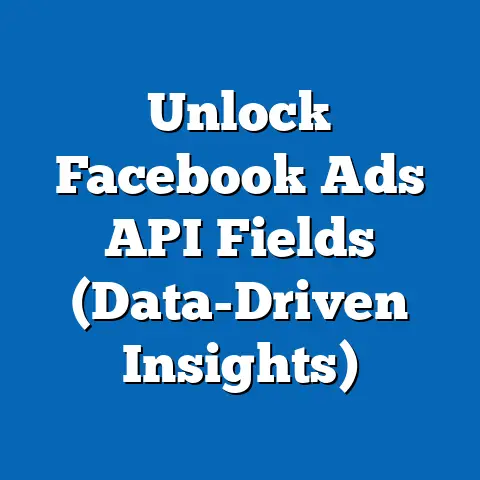Master Facebook Ads for Website (Expert Strategies)
As digital advertising continues to dominate marketing budgets worldwide, Facebook Ads remains a powerhouse for driving website traffic and conversions. With over 2.9 billion monthly active users as of 2023 (Statista, 2023), the platform offers unparalleled reach for businesses targeting diverse demographics. Looking to the future, trends indicate that Facebook Ads will evolve with advancements in AI-driven targeting, increased mobile ad spend, and a growing emphasis on privacy regulations, shaping how marketers optimize campaigns for website traffic.
Key statistics highlight the platform’s enduring relevance: global digital ad spending is projected to reach $740 billion by 2025, with social media ads accounting for 33% of this figure (eMarketer, 2023). Within this, Facebook holds a significant 21.9% share of the social media ad market. Demographic shifts show younger users (18-24) decreasing slightly in engagement, while older cohorts (35-54) are increasing their presence on the platform, necessitating tailored strategies.
Historically, Facebook Ads have transitioned from broad, untargeted campaigns in the late 2000s to hyper-personalized, data-driven approaches by the 2020s. Future projections suggest that by 2027, over 60% of Facebook Ad campaigns will leverage machine learning for optimization (Forrester, 2023). This article delves into expert strategies for mastering Facebook Ads for website traffic, analyzing current trends, demographic insights, historical shifts, and actionable tactics for the future.
The Future of Facebook Ads: Key Statistical Trends and Projections
Rising Investment in Digital and Social Media Ads
Digital advertising is on an upward trajectory, with social media platforms like Facebook at the forefront. According to eMarketer (2023), global social media ad spending is expected to grow at a compound annual growth rate (CAGR) of 9.3% from 2023 to 2027, reaching $270 billion by the end of the forecast period. Facebook, including Instagram under Meta’s umbrella, is projected to maintain a dominant 21-23% market share during this time.
This growth is driven by increased mobile usage, with mobile ads accounting for 75% of Facebook’s ad revenue in 2023, up from 66% in 2019 (Statista, 2023). Marketers must prioritize mobile-optimized campaigns to capture this audience. Additionally, emerging markets in Asia-Pacific and Latin America are expected to contribute significantly to ad spend growth, with a projected 12% CAGR in these regions through 2027 (eMarketer, 2023).
AI and Automation in Ad Optimization
Artificial intelligence (AI) is revolutionizing Facebook Ads, with tools like Meta’s Advantage+ automating campaign management. Research from Forrester (2023) predicts that by 2025, 80% of advertisers will use AI-driven tools for audience targeting and bid optimization. Early adopters have reported a 20-30% increase in return on ad spend (ROAS) when using automated bidding strategies.
However, privacy changes, such as Apple’s App Tracking Transparency (ATT) framework introduced in 2021, have limited data access, pushing Meta to enhance its on-platform AI models. By 2027, it’s estimated that AI will mitigate up to 70% of data loss impacts through contextual targeting and lookalike audience modeling (Gartner, 2023). Marketers should prepare for a future where creativity and first-party data are as critical as algorithmic precision.
Privacy Regulations and User Trust
Data privacy will remain a pivotal concern shaping Facebook Ads. The General Data Protection Regulation (GDPR) in Europe and the California Consumer Privacy Act (CCPA) in the U.S. have already forced advertisers to adapt to stricter consent requirements. A 2023 survey by Pew Research found that 68% of users are concerned about how social media platforms use their data, influencing Meta to invest in privacy-focused ad solutions.
Future projections indicate that by 2026, over 50% of global internet users will be covered by comprehensive data privacy laws (Cisco, 2023). This necessitates a shift toward transparent ad practices and reliance on anonymized data aggregation. Marketers must build trust through clear messaging and ethical data use to maintain campaign effectiveness.
Demographic Breakdowns: Who’s Engaging with Facebook Ads?
Age and Gender Insights
Facebook’s user base is diversifying, with significant implications for ad targeting. As of 2023, 18-24-year-olds account for 23% of users, down from 29% in 2018, while the 35-54 age group has grown to 32% from 26% over the same period (Statista, 2023). This shift reflects younger users migrating to platforms like TikTok, while older demographics remain loyal to Facebook for community engagement and news.
Gender distribution remains relatively balanced, with 56% male and 44% female users globally. However, women aged 25-34 show higher engagement rates with e-commerce ads, clicking at a rate of 3.2% compared to 2.5% for men in the same age group (Hootsuite, 2023). Tailoring creative content—such as using relatable imagery for women or action-oriented messaging for men—can optimize click-through rates (CTR) for website traffic.
Geographic and Economic Variations
Geographically, North America and Europe account for 45% of Facebook’s ad revenue despite representing only 15% of its user base, due to higher purchasing power and ad costs (Meta Q3 2023 Earnings Report). In contrast, Asia-Pacific contributes 30% of revenue with 40% of users, highlighting cost-effective opportunities for advertisers targeting emerging markets.
Income levels also influence ad performance. Users in high-income brackets (above $75,000 annually) are 25% more likely to convert on premium product ads, while lower-income users respond better to discount-driven campaigns (Nielsen, 2023). Marketers should segment audiences by region and income to maximize relevance and drive website visits.
Behavioral Trends Across Demographics
Behavioral data reveals distinct patterns in ad interaction. For instance, 18-34-year-olds are 40% more likely to engage with video ads, while users over 45 prefer static image ads with clear calls-to-action (Sprout Social, 2023). Additionally, parents aged 25-44 show a 15% higher CTR on family-oriented products compared to non-parents in the same age group.
These insights underscore the importance of audience segmentation. By leveraging Facebook’s detailed targeting options—such as interests, behaviors, and life events—marketers can create hyper-relevant campaigns that resonate with specific demographic groups, ultimately driving more traffic to websites.
Historical Comparisons: How Facebook Ads Have Evolved
Early Days (2007-2012): Broad Reach and Limited Targeting
When Facebook Ads launched in 2007, the platform focused on broad demographic targeting with minimal personalization. Early campaigns had average CTRs of 0.05-0.1%, reflecting low user engagement and rudimentary ad formats (AdAge, 2010). Ad spend was modest, with global revenue of $4.3 billion by 2012, compared to $114.9 billion in 2022 (Meta Annual Reports).
During this period, driving website traffic was secondary to brand awareness. Most ads linked to Facebook Pages rather than external sites, limiting direct conversions. The lack of mobile optimization also hindered performance, as only 14% of users accessed the platform via mobile in 2010 (Statista, 2012).
Mid-2010s (2013-2018): Mobile Boom and Data-Driven Targeting
The mid-2010s marked a turning point with the rise of mobile usage and sophisticated targeting. By 2015, 78% of Facebook users accessed the platform via mobile, prompting a surge in mobile ad spend to 65% of total revenue (Meta, 2015). CTRs improved to 0.9% on average, driven by the introduction of Custom Audiences and Lookalike Audiences.
Website traffic campaigns gained traction with the rollout of conversion tracking via the Facebook Pixel in 2013. Marketers could now measure direct outcomes, leading to a 200% increase in ad spend on traffic objectives between 2014 and 2018 (eMarketer, 2018). This era laid the groundwork for today’s data-centric strategies.
Recent Years (2019-2023): Privacy Challenges and AI Integration
The late 2010s and early 2020s brought challenges with privacy regulations and signal loss. Apple’s ATT update in 2021 reduced Meta’s ad revenue by an estimated $10 billion in 2022 due to restricted tracking (Meta Q1 2022 Earnings Call). Average CTRs dipped slightly to 0.85% as targeting accuracy waned.
However, Meta countered with AI enhancements, such as Automated Ads and Advantage+ campaigns, which boosted ROAS by 15-20% for early adopters (Forrester, 2022). Website traffic campaigns became more dynamic with features like Dynamic Ads, allowing real-time product updates. Historical data shows a clear shift from manual to automated optimization, a trend set to intensify.
Expert Strategies for Mastering Facebook Ads for Website Traffic
1. Leverage Advanced Audience Targeting
Despite privacy constraints, Facebook’s targeting capabilities remain robust. Use first-party data—such as email lists or website visitor data—to build Custom Audiences for retargeting. Studies show retargeted ads have a 70% higher conversion rate for website visits compared to cold audiences (WordStream, 2023).
Additionally, test Lookalike Audiences based on high-value segments, such as past purchasers or engaged visitors. Expand reach by layering interest-based targeting, but keep audiences narrow (500,000-1 million) to maintain relevance. Regularly refresh audiences to avoid ad fatigue, which can reduce CTR by 30% after two weeks of exposure (Hootsuite, 2023).
2. Optimize for Mobile-First Experiences
With 75% of ad impressions on mobile, campaigns must prioritize mobile optimization. Use vertical video formats (9:16) for Stories and Reels, which have a 20% higher engagement rate than horizontal formats (Meta, 2023). Ensure landing pages are mobile-friendly, as 40% of users abandon sites that take over 3 seconds to load (Google, 2023).
Test mobile-specific ad objectives, such as Traffic or Conversions, and use dynamic creative to adapt visuals based on device type. Monitor metrics like mobile CTR (currently averaging 1.1% vs. 0.7% on desktop) to fine-tune campaigns (Statista, 2023). A seamless mobile experience is non-negotiable for driving website traffic.
3. Harness AI and Automation Tools
Meta’s AI tools, like Advantage+ Placements, simplify campaign management while improving outcomes. Advertisers using automated bidding (e.g., Target Cost or Lowest Cost) report a 25% reduction in cost-per-click (CPC) compared to manual bidding (Meta, 2023). Set clear goals—such as maximizing clicks or conversions—to guide the algorithm.
Experiment with Advantage+ Creative, which tests multiple ad variations to identify top performers. Allocate 10-15% of your budget to testing new AI features, as early adoption often yields a competitive edge. Balance automation with human oversight to ensure brand alignment and creative quality.
4. Create Compelling Ad Creative
Creative remains king in driving website traffic. Video ads, which account for 50% of ad impressions, have a 35% higher CTR than static images (Sprout Social, 2023). Use short, engaging videos (15-30 seconds) with strong hooks in the first 3 seconds to capture attention.
Incorporate clear calls-to-action (CTAs) like “Learn More” or “Shop Now,” which boost click rates by 20% (WordStream, 2023). Test carousel ads for showcasing multiple products or benefits, as they drive 10-15% more clicks than single-image ads. Refresh creative every 7-14 days to maintain user interest and avoid ad fatigue.
5. Focus on Retargeting and Funnel Optimization
Retargeting is a proven tactic for driving website traffic, with 60% of users more likely to revisit a site after seeing a retargeted ad (Criteo, 2023). Use the Facebook Pixel to track visitors and segment them by behavior—such as page views, time spent, or abandoned carts. Tailor ads to each segment, offering incentives like discounts to re-engage users.
Optimize the entire funnel by aligning ad messaging with landing page content. A 2023 study found that mismatched ad-to-landing page experiences result in a 50% drop-off rate (Unbounce, 2023). Streamline the user journey with fast-loading pages and clear navigation to maximize conversions from ad clicks.
6. Adapt to Privacy Changes
With tracking limitations, contextual targeting is gaining importance. Focus on in-platform behaviors, such as group memberships or page likes, to infer user interests. A 2023 report by Gartner suggests that contextual ads can achieve 80% of the effectiveness of personalized ads when executed well.
Collect first-party data through lead forms or on-site interactions to build sustainable audience lists. Communicate transparently about data usage in ad copy to build trust, as 55% of users are more likely to engage with brands that prioritize privacy (Pew Research, 2023). Future-proof campaigns by reducing reliance on third-party cookies.
Statistical Comparisons Across Campaign Types and Industries
Performance by Objective: Traffic vs. Conversions
Campaign objectives significantly impact performance metrics. Traffic campaigns average a CPC of $0.63 and a CTR of 1.29%, while conversion campaigns have a higher CPC of $1.85 but a lower CTR of 0.77% (WordStream, 2023). For website traffic goals, prioritize the Traffic objective but layer in conversion tracking to measure downstream impact.
Industries also vary widely in ad performance. E-commerce sees an average CTR of 1.6% due to visual product appeal, while B2B services lag at 0.8% due to longer decision cycles (Hootsuite, 2023). Tailor budgets and expectations based on industry benchmarks to set realistic goals.
Cost and Engagement by Demographic
Younger audiences (18-24) have the lowest CPC at $0.50 but require frequent creative updates due to ad fatigue. In contrast, the 35-54 age group has a higher CPC of $0.85 but sustains engagement longer, with a 10% higher click duration on websites (Statista, 2023). Allocate budgets based on cost-efficiency and engagement potential per demographic.
Gender differences also play a role. Women’s average CPC is $0.68 compared to $0.75 for men, reflecting higher competition for male audiences in certain verticals like tech (WordStream, 2023). Adjust bids and creative strategies to balance cost and performance across genders.
Future Projections: What Lies Ahead for Facebook Ads
Growth in Emerging Markets
By 2027, Asia-Pacific and Latin America are projected to account for 50% of Facebook’s user growth, driven by increasing internet penetration (eMarketer, 2023). Ad costs in these regions will remain 30-40% lower than in North America, offering cost-effective scaling opportunities. Marketers should localize content and test campaigns in high-growth markets like India and Brazil.
Dominance of Video and Interactive Formats
Video will continue to dominate, with projections estimating that 70% of ad impressions will be video-based by 2026 (Meta, 2023). Emerging formats like Reels and interactive ads (e.g., polls or AR experiences) are expected to drive a 25% increase in engagement rates. Invest in short-form video production and experiment with interactive elements to stay ahead of the curve.
AI-Driven Personalization at Scale
AI will further refine ad delivery, with 90% of campaigns expected to use automated optimization by 2027 (Forrester, 2023). This will lower average CPC by 15-20% as algorithms improve efficiency. However, human creativity will remain essential for storytelling and brand differentiation in a hyper-automated landscape.
Privacy as a Competitive Advantage
As privacy laws expand, brands that prioritize ethical data practices will gain a competitive edge. By 2026, 60% of consumers are expected to favor brands with transparent ad policies (Cisco, 2023). Build long-term trust by adopting privacy-first strategies, such as zero-party data collection through quizzes or surveys.
Conclusion: Preparing for the Future of Facebook Ads
Mastering Facebook Ads for website traffic requires a blend of data-driven precision and adaptive creativity. Current trends underscore the importance of mobile optimization, AI automation, and demographic targeting, while historical shifts highlight the platform’s evolution from broad reach to personalized engagement. Future projections point to a landscape shaped by privacy regulations, video dominance, and emerging market growth.
Marketers must stay agile, leveraging tools like Advantage+ while crafting compelling creative that resonates with diverse audiences. By focusing on first-party data and transparent practices, businesses can build trust and sustain performance amidst evolving challenges. As Facebook Ads continues to innovate, those who anticipate and adapt to change will drive the most impactful website traffic and conversions in the years ahead.

